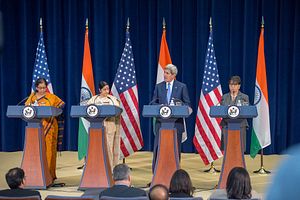The first U.S.-India Strategic and Commercial Dialogue wrapped up in Washington D.C. today. U.S. Secretary of State John Kerry and Secretary of Commerce Penny Pritzker met with their Indian counterparts, Sushma Swaraj, the external affairs minister, and Nirmala Sitharaman, the minister of state for commerce and industry. The dialogue resulted in a joint statement outlining a range of new bilateral commitments and initiatives, and builds on the momentum in bilateral ties generated during Indian Prime Minister Narendra Modi’s September 2014 trip to the United States, and U.S. President Barack Obama’s reciprocal trip to India in January 2015. The joint statement and related statements and speeches from the two days of talks are posted on the U.S. State Department’s website here.
The “strategic” component of the dialogue was outweighed by the “commercial” side. Though both sides gave lip service to important strategic issues relevant to the U.S.-India bilateral relationship, including regional stability, terrorism, nonproliferation, Afghanistan, and the recent deal over Iran’s nuclear program, there was little new. Both sides addressed the issue of terrorism with a specific joint statement, which, among other things, called on Pakistan to bring the perpetrators of the 2008 Mumbai terror attacks to justice. What’s notable in the broader statement, however, is that the U.S. thanked India for its “leadership in evacuating foreign nationals, including U.S. citizens, from conflict in Yemen” (you can read about India’s involvement in Yemen in my earlier report for The Diplomat here). Additionally, both sides highlighted an upcoming India-U.S.-Japan trilateral meeting on the sidelines of the 70th UN General Assembly (Japan is also set to return to the Malabar joint naval exercise this year). The statement also notes the United States’ support for India’s UN Security Council bid as a permanent member, which remains unchanged since 2010.
On defense, the joint statement noted that both sides “expressed satisfaction” with progress on the Defense Technology and Trade Initiative pathfinder projects, including the ongoing feasibility studies for bilateral cooperation on aircraft carrier and jet engine technology. Overall, the dialogue included few details on defense issues, which will be more fully fleshed out during the next meeting of the leaders or top defense officials. U.S. Secretary of Defense Ashton Carter visited India in late May, where he and his Indian counterpart, Manohar Parrikar, signed a 10 year defense framework agreement, updating the 2005 document. Most notably, in the joint statement the two sides agreed to jointly train troops in six African countries for UN peacekeeping missions. As the Strategic and Commercial Dialogue concluded, the Indian cabinet announced that New Delhi had approved a $2.5 billion deal to purchased 37 military helicopters from Boeing.
The commercial and energy side of the talks were more comprehensive. The United States welcomed the electoral victory of the Bharatiya Janata Party (BJP) in last year’s general elections in India, perceiving the party as one more favorable to continuing India’s overall economic liberalization, which it has been. In the most recent talks, the U.S. side emphasized its satisfaction with the Modi government’s ongoing reforms. The two sides also announced new initiatives, including a “joint work stream” intended to facilitate the sharing of “best practices on cross- border trade, and to continue commercial law-related initiatives on issues like insolvency and contract enforcement, and transparency.” At the conclusion of the talks, Pritzker cited the aforementioned helicopter deal with Boeing as a “clear indication of Prime Minister Modi’s leadership in improving the ease of doing business in his country.”
Parallel to the strategic and commercial dialogue, high-level representatives from both sides discussed issues related to climate change and energy—a priority for both sides in the lead up to the COP21 talks later this year in Paris. During the Strategic and Commercial Dialogue, U.S. Secretary of Energy Ernest Moniz and Indian Minister of State for Power, Coal, and New & Renewable Energy Piyush Goyal convened the U.S.-India energy dialogue, picking up on a range of initiatives that had been launched during Modi’s September 2014 trip to the United States. Additionally, high-level representatives also convened a U.S.-India joint working group on climate change. Both sides came to several agreements on clean energy and enhancing climate change cooperation.
This year’s strategic and commercial dialogue falls into a long series of high-level bilateral encounters, including Modi’s U.S. trip, Obama’s India trip, and Carter’s India visit. between the U.S. and India over the past 16 months. The vast range of topics discussed during this dialogue emphasizes the extent to which the U.S.-India relationship has really seen a profusion in both its breadth and depth in recent years. To book-end a year of breakneck bilateral positivity, Modi is set to meet Obama on the sidelines of the United Nations General Assembly in New York next week.
The full 2015 U.S.-India strategic and commercial dialogue joint statement is available here.

































